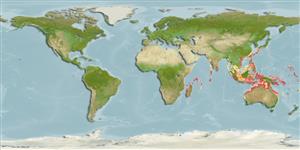Environment: milieu / Zona climática / intervalo de profundidade / distribution range
Ecologia
marinhas associadas(os) a recifes; pH range: 22.0 - 28.5; intervalo de profundidade 5 - 40 m (Ref. 90102). Tropical
Indo-West Pacific: Madagascar to Indonesia and Australia (Ref. 2334, 3131).
Tamanho / Peso / Idade
Maturidade: Lm ? range ? - ? cm
Max length : 65.0 cm SL macho/indeterminado; (Ref. 48637)
Espinhos dorsais (total) : 6 - 7; Raios dorsais (total) : 28 - 31; Espinhos anais: 3; Raios anais : 19 - 23. Adults (above 40 cm) silvery, with dark bar through eye and another (faint) bar just behind head. Fins dusky. Small juveniles black, vertical white lines on body and fins. Subadults brown, with black bar from nape, over eye to chest and another black bar from dorsal-fin origin, over pectoral fins to pelvic fins, pectoral and pelvic fins dark brown or black. Body orbicular and strongly compressed, its depth more than twice length of head and 1.1 to 1.9 times in SL. Snout profile of large adults (above 40 cm) concave, with prominent bony swelling between eyes. Jaws with bands of slender, flattened, tricuspid teeth, the middle cusp 3 to 4 times longer than lateral cusps. Vomer with a band of strong teeth, no teeth on palatines. Five pores on each side of lower jaw. Preopercle smooth. Opercle without spines (Ref 43039).
Body shape (shape guide): short and / or deep.
Inhabits continental reefs (Ref. 9710). Adults usually moderately deep on open substrates with sparse reef or coral heads. A solitary species, but occasionally in pairs or small groups. Small juveniles also in deep water and the zebra-pattern serves well as camouflage when sheltering with crinoids (Ref. 48637). Juveniles in shore waters; adults in deeper water. Possible to breed in the aquarium (Ref. 130623).
Ciclo de vida ou comportamento de acasalamento
Maturidade | Reprodução | Desova | Ovos | Fecundidade | Larvas
Sainsbury, K.J., P.J. Kailola and G.G. Leyland, 1985. Continental shelf fishes of the northern and north-western Australia. An illustrated guide. CSIRO Division of Fisheries Research; Clouston & Hall and Peter Pownall Fisheries Information Service, Canberra, Australia. 375 p. (Ref. 3131)
Status na Lista Vermelha da UICN (Ref. 130435: Version 2025-1)
Ameaça para os humanos
Harmless
Uso pelos humanos
Pescarias: espécies comerciais; Aquário: Espécies comerciais
Ferramentas
Relatórios especiais
Baixar XML
Fontes da internet
Estimates based on models
Preferred temperature (Ref.
123201): 25.1 - 29, mean 27.9 °C (based on 558 cells).
Índice de diversidade filogenética (Ref.
82804): PD
50 = 0.5313 [Uniqueness, from 0.5 = low to 2.0 = high].
Bayesian length-weight: a=0.02692 (0.01132 - 0.06402), b=2.94 (2.74 - 3.14), in cm total length, based on LWR estimates for this (Sub)family-body shape (Ref.
93245).
Nível Trófico (Ref.
69278): 3.5 ±0.37 se; based on food items.
Resiliência (Ref.
120179): Baixo, tempo mínimo de duplicação da população 4,5 - 14 anos (Preliminary K or Fecundity.).
Fishing Vulnerability (Ref.
59153): Moderate to high vulnerability (52 of 100).
🛈
Nutrients (Ref.
124155): Calcium = 31.7 [16.8, 52.8] mg/100g; Iron = 0.472 [0.288, 0.735] mg/100g; Protein = 18.8 [17.6, 19.9] %; Omega3 = 0.0935 [, ] g/100g; Selenium = 36.6 [20.8, 64.8] μg/100g; VitaminA = 45.6 [13.6, 147.6] μg/100g; Zinc = 0.924 [0.657, 1.303] mg/100g (wet weight);
